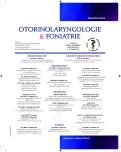Virtual Reality as a Training Method in the Area of FESS and Skull Base
Authors:
P. Šurda 1; Miroslav Tedla 2,3,4; D. Baldwin 3
Authors‘ workplace:
ENT department, University Hospitals Bristol
1,3; ENT department, University Hospitals Coventry and Warwickshire
2; Klinika ORL a chirurgie hlavy a krku Univerzity Komenského, Bratislava
2; InHANSE Birmingham
4
Published in:
Otorinolaryngol Foniatr, 64, 2015, No. 2, pp. 98-101.
Category:
Review Article
Overview
Being a surgeon and pilot carries the mutual risk that even a small failure can lead into the catastrophic and fatal events. In order to shorten the learning curve and minimize the risk of a failure, aviation introduced and implemented the first virtual reality simulator (VS) into the training program, which significantly increased the aviation safety. This led to the construction of the first endoscopic endonasal VS by Lockheed in 1996. Thereafter, numerous ENT departments obtained VS, but the fact is low usage by residents and missing integration into the training program. In this literature review we discuss the need of the VS integration into the ENT training program and present the new technologies in the field of VS.
Keywords:
virtual reality simulator, endoscopic endonasal surgery, ENT training
Sources
1. Bakker, N. H., Fokkens, W. J., Grimbergen, C. A.: Investigation of training needs for functional endoscopic sinus surgery (FESS). Rhinology, 43, 2005, 2, s. 104-108.
2. Edmond, C. V., Heskamp, D., Sluis, D. et al.: ENT endoscopic surgical training simulator. Stud. Health. Technol. Inform., 39,1997, s. 518-528.
3. Dongen, K. W., Schijven, M., Rinkes, I. H.; Broeders, J.: Virtual reality training for endoscopic surgery: voluntary or obligatory? Surgical Endoscopy, 22, 2008, 3, s. 664-667.
4. Fokkens, W., Lund, V., Mullol, J. et al.: EPOS 2012: European position paper on rhinosinusitis and nasal polyps. Rhinology, 50, 2012, 1, s. 55.
5. Fried, M. P., Sadoughi, B., Weghorst, S. J., et al.: Construct validity of the endoscopic sinus surgery simulator: II. Assessment of discriminant validity and expert benchmarking. Arch. Otolaryngol. Head. Neck. Surg., 133, 2007, s. 350-357.
6. Hing, E., Cherry, D. K., Woodwell, D.A.: National ambulatory medical care survey: 2004 summary. Advance data from Vital and Health Statistics, 372, 2006, s. 1-29.
7. Hyltander, A., Liljegren, E., Rhodin, P. H., Lonroth, H.: The transfer of basic skills learned in a laparoscopic simulator to the operating room. Surg. Endosc., 16, 2002, s. 1324-1328.
8. Lynn-Macrae, A. G., Lynn-Macrae, R. A., Emani, J. et al.: Medicolegal analysis of injury during endoscopic sinus surgery. Laryngoscope, 114, 2004, s. 1492-1495.
9. Ruthenbeck, G. S., Hobson, J., Carney, A., Sloan, S. B., Sacks, R., Reynolds, K.: Towards photorealism in endoscopic sinus surgery simulation. American Journal of Rhinology and Allergy, 27 , 2013, 2. s. 138-143.
10. Ruthenbeck, G. S., Reynolds, K.: Virtual reality surgical simulator software development tools. Journal of Simulation, 7, 2013, s. 101-108.
11. Ruthenbeck, G. S.,Reynolds, K.: Virtual reality for medical training: the state-of-the-art. Journal of Simulation, 2014, s. 1-11.
12. Ruthenbeck, G. S., Tan, S., Carney, A., Hobson, J., Reynolds, K.: A virtual-reality subtotal tonsillectomy simulator. Journal of Laryngology & Otology, 126, 2012, s. S8-S13.
13. Schijven, M. P., Jakimowicz, J. J., Broeders, I. A., Tseng, L. N.: The Eindhoven laparoscopic cholecystectomy training course—improving operating room performance using virtual reality training: results from the first E.A.E.S. accredited virtual reality trainings curriculum. Surg. Endosc., 19, 2005, s. 1220–1226.
14. Stankiewicz, J. A.: Complications of endoscopic intranasal ethmoidectomy. Laryngoscope, 97, 1987, s. 1270-1273.
15. Šoltés, M., Radoňak, J.: Využiteľnosť krátkodobého modelu tréningu základných laparoskopických zručností vo virtuálnej realite v pregraduálnom vzdelávaní. Slov. Chir., 10, 2013, 3, s. 106-109.
16. Tendick, F., Jennings, R. W., Tharp, G. et al.: Sensing and manipulation problems in endoscopic surgery: experiment, analysis and observation. Presence, 2, 1993, s. 66-81.
17. Tolley, N., Arora, A.: Virtual reality simulation training in Otolaryngology. Int. J. Surg., 12, 2014, 2, s. 87-94.
18. Tolsdorff, B., Pommert, A., Hohne, K. H., Petersik, A., Pflesser, B., Tiede, U. Leuwer, R.: Virtual reality: A new paranasal sinus surgery simulator. Laryngoscope, 120, 2010, 420-426
19. van der Zee, D. C., Broeders, I. A.: European consensus on a competency-based virtual reality training program for basic endoscopic surgical psychomotor skills. Surgical Endoscopy, 25, 2011, s. 166-171.
Labels
Audiology Paediatric ENT ENT (Otorhinolaryngology)Article was published in
Otorhinolaryngology and Phoniatrics

2015 Issue 2
Most read in this issue
- Augmentation of Vocal Cords by Autologous Fat
- Present Diagnostics and Therapy of Inflammations of Maxillary Sinuses in the Czech Republic – Evaluation of a Questionnaire Survey
- Juvenile Recurrent Parotitis and Selective IgA Deficiency
- Massive Cervical Hematoma Developed Due to Spontaneous Rupture of External Carotid Artery
